 German Empire – 200 submarines, 96 comp. UB-48 to UB-155
German Empire – 200 submarines, 96 comp. UB-48 to UB-155WW1 German U-Boats
Brandtaucher | Forelle | U-1 | U-2 | U-3 class | U-5 class | U-9 class | U-13 class | U-17 class | U-19 class | U-23 class | U-43 class | U-57 class | U-63 class | U-87 class | U-93 class | U-139 class | U-142 class | UA | UB-I class | UB-II class | UB-III class | UC-I class | UC-II class | UC-III | Deutschland | UE-I class | UE-II class | U-ProjectsThe UB-III became the mainstay of the the German submarine force in WWI. They were also arguably the best of the whole lineage, albeit not coming from 1st class boats from from a coastal type lineage. If the UB-I and UB-II had been successful on their own right, they still had a lot of issues. Thus were designed two-shafts, much larger and more balanced boats, with extra torpedo armament. They eventually became the most produced submarine of that era with 200 on order, before being eclipsed her “successor”, the Type VII of WW2 fame, via the cover of a design bureau at the Hague… Despite their late arrival into the war in 1917, the UB-III did better than their predecessors, sinking 521 ships (1,123,211 GRT) and 7 warships.
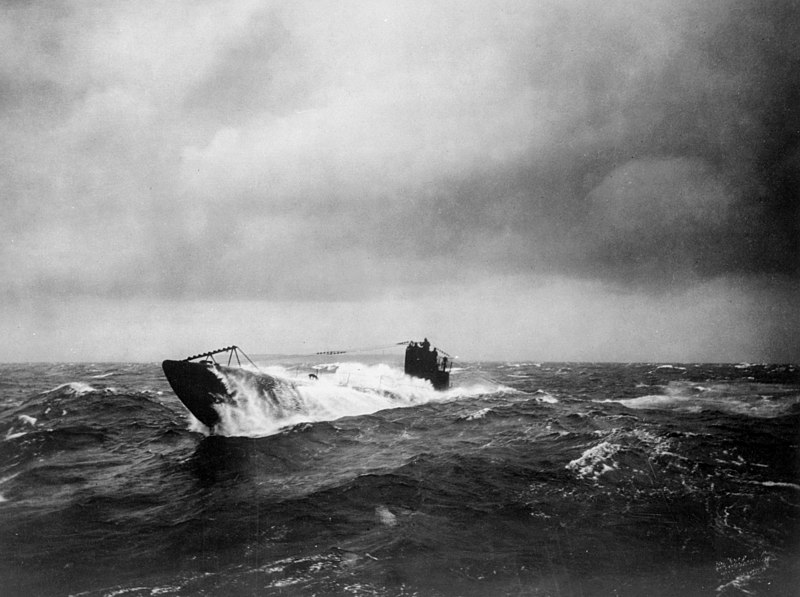
A famous photo: UB 148 en route to the USA, surfaced and in heavy weather
Design genesis of the UB-III
The UB III draw less from the preceding Ub-IIs than from the other specialized U-Boat branch of the time, the minelayer types (UC), and especially the very successful UC IIs which gained their reputation by sinking more than 1,800 Allied and neutral vessels. German engineers were thus asked to improve on the design and create a pure torpedo launching vessel, perfectly in line for an unrestricted surb warfare. Their task was to greatly expand its potential, for what was a fairly capable design, incorporating as many features and creating the “perfect submersible torpedo boat”.
The UB-III indeed had nothing to do with the UB-II, despite sharing the same lineage. This was a brand new league in submarine design.
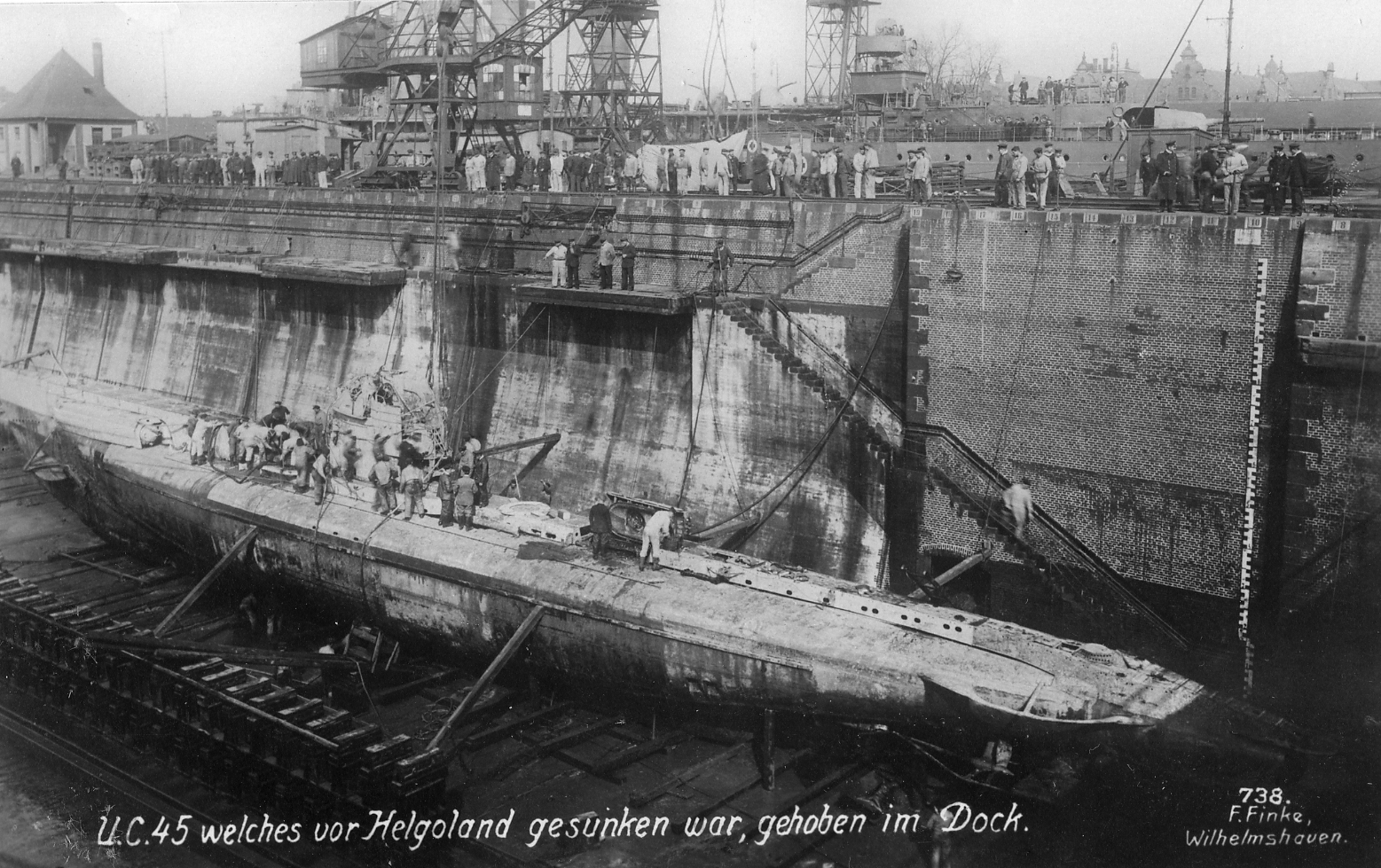
UC-II type UC-45 in drydock maintenance. The UB-III were directly modelled on these.
Final design

The hull displaced 508 tonnes (500 long tons) for the first serie, and 555 tonnes (546 long tons) surfaced and 629 t (619 long tons) and 684 t (673 long tons) submerged for the second serie.
The hull length for the first serie was 55.30 (181 ft 5 in) overall, and 57.80 m (189 ft 8 in) overall for the second serie. The internal, pressure hull measured for all versions 40.10 m (131 ft 7 in). The hull beam for the first serie was 5.76 meters (18 ft 11 in) for the first serie and 5.80 m (19 ft) for the second. Draught for the first serie was 3.67 m (12 ft) and 3.85 m (12 ft 8 in) for the second. Complement was larger than previous UB classes, with three officers, generally a Frigate Lieutnenant, a petty officers and XO, and 31 ratings.
Hull Design
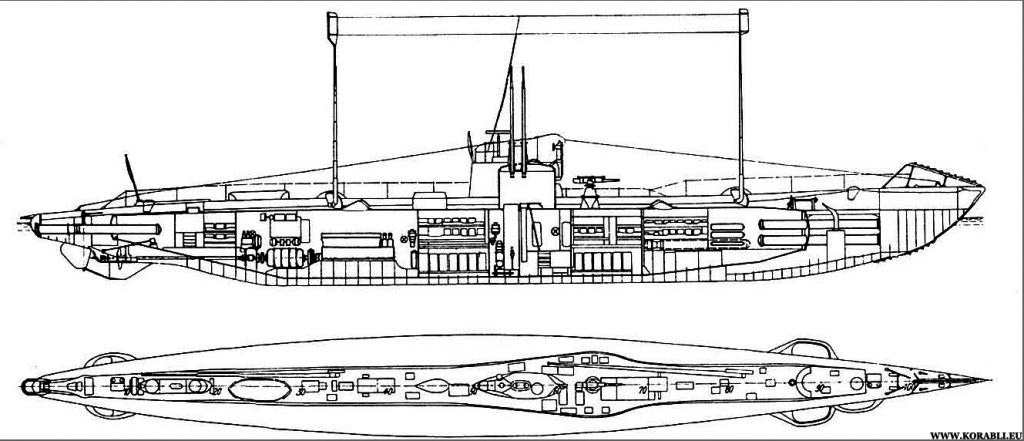
More detailed cutout (src korableu)
The original UC-II design displaced 417 tons for 53m long for the second version (49 for the first) and still had 7 torpedoes (2× 50 cm bow, one internal stern tube) and up to 18 mines in six triple chutes, three per side. They were double-hulled with improved range and seakeeping, and were seen as an excellent design base. The order for 64 boat was completed befiore the end of the war.
This was seen as a good design to start with by Blohm & Voss for high seas operations as requested by the High Command. The Yard would be responsible for the first six.
Powerplant and Performances
The UB-III had about the same powerplant as the UC-II, with two 6-cylinder 4-stroke MAN diesel engines, for a total of 1,060 PS (780 kW; 1,045 shp) for the first serie, and 1,100 PS (809 kW; 1,085 shp) for the second one. They reloaded batteries coupled to two Siemens-Schuckert Electric motors rated for 788 PS (580 kW or 777 shp). Thy ran at 450 rpm surfaced and 362 rpm submerged.
They drove two shafts, each driving a 1.40 m (4 ft 7 in) propeller. Top speed due to this power improvement varied, the first serie was capable of 13.2 knots (24.4 km/h; 15.2 mph) surfaced and 7.4 knots (13.7, 8.5 mph) submerged. The second serie could reach 13.9 knots (25.7 kph or 16 mph) surfaced and 8 knots (14.8 kph and 9.2 mph) submerged.
As for Range, it was well improved between the two series:
The first one could reach 7,120 nmi (13,190 km; 8,190 mi) at 6 knots (11 kph; 6.9 mph) surfaced and 50 nmi (93 km; 58 mi) at 4 knots (7.4 kph; 4.6 mph) submerged and for the second serie 9,090 nmi (16,830 km; 10,460 mi) at 6 knots surfaced and 55 nmi (102 km; 63 mi) at 4 knots submerged.
For both, the test depth was 50 m (160 ft).
Armament
As shown in the the construction tables below, Armament varied between ship and over time, but there was at least a standard for torpedo tubes.
The first serie for example had four 50 cm (19.7 in) bow torpedo tubes and one stern tube. The stern tube was eliminated for the UB-80 series onwards as rarely used, and converted into extra storage. There was even the case of UB 12 rebuilt as a minelayer in 1918 with eight 8 mines and the bow TTs removed.
If the early series had four bow tubes and one aft, they also had one reload for each, so ten torpedoes. As there was no space aboard for two spares, the ready torpedoes were already in the tubes.
Deck armament changed, with one simple machine gun for the first serie UB-48 (later rearmed) and from UB-54 a 8.8 cm (3.5 in) SK L/30 deck gun as standard.
As the war progressed the latter was replaced when possible by a 10.5 cm (4.1 in) SK L/45 deck gun in 1918. The last series had the latter as standard.
There was also an interesting experiment, UB 106, which had both a 88mm aft and 105mm forward as an experiment for better surface defence.
German standard Torpedoes
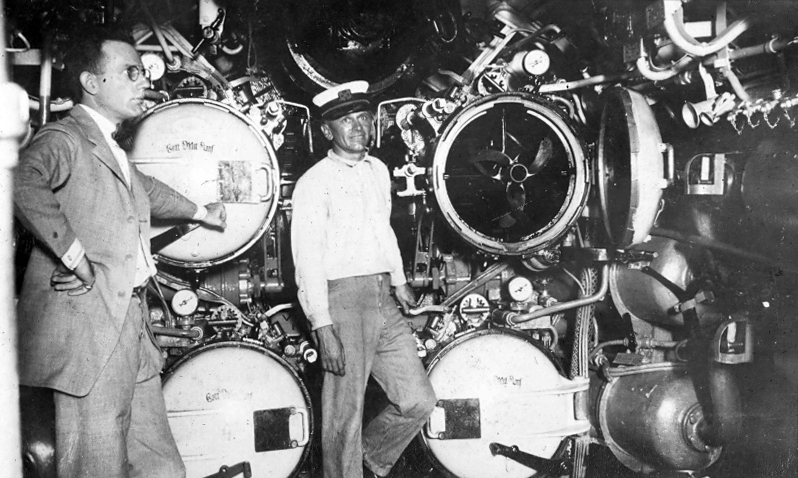
Torpedo room of UB-88 in 1920, inspected by the allies
This was the 50 cm (19.7″) G/6 used on all U-boats from U-19 and by that stage the better G/6D
Designed in 1908 it entered service in 1911 and became standard.
⚙ Specs G6D* |
|
| Overall Length | 236 in (6.000 m) |
| Explosive Charge* | 362 lbs. (164 kg) TNT/Hexanitrodephenylamin (Hexanite) |
| Range/Speed | 9,190 yards (8,400 m)/27 knots or 3,830 yards (3,500 m)/35 knots |
| Power | Kerosene Wet-Heater |
8.8 cm (3.5 in) SK L/30
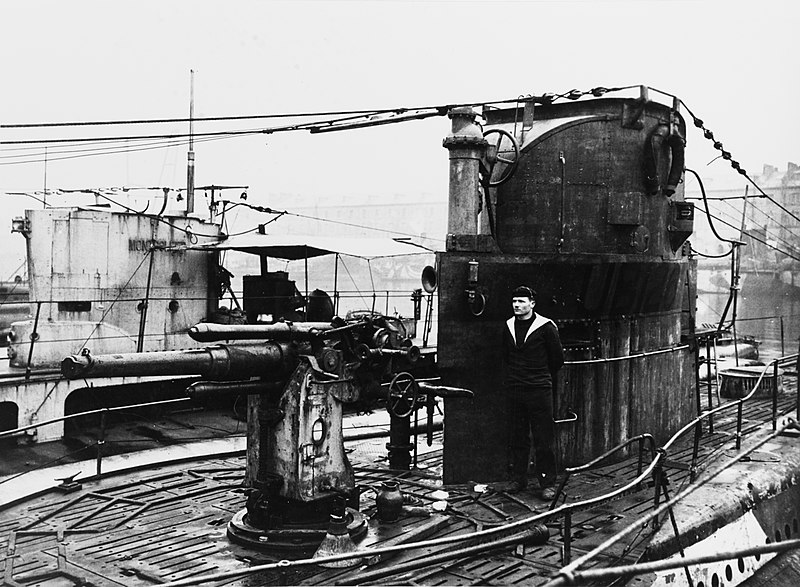
Captured UB-126 at Cherbourg showing her 88mm deck gun.
⚙ Specs G6 |
|
| Mass | 644 kilograms (1,420 lb) |
| Length | 2.64 meters (8 ft 8 in) |
| Shell | Fixed HE 7 kilograms (15 lb) 3.5 in |
| Breech | horizontal sliding-wedge |
| Elevation | Ubts.L: -10° to +30° |
| Rate of fire | 15 RPM |
| Muzzle velocity | 590 m/s (1,900 ft/s) |
| Max. range | Ubts.L: 10,500 metres (11,500 yd) at +30° |
10.5 cm (4.1 in) SK L/45
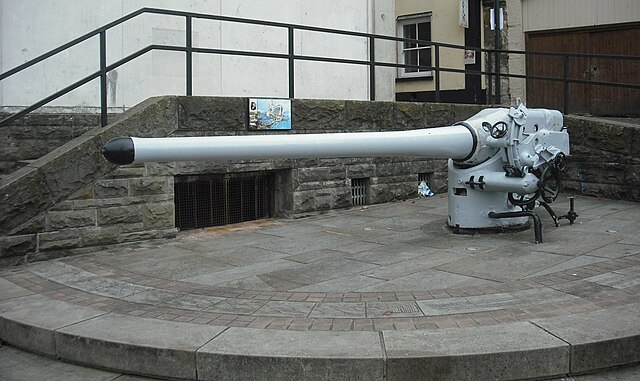
105 mm SK L/45 from UB-91 exposted at Chepstow
The second type mounted either on serie from the two latter series, or to replace 88mm deck guns on many ships in 1918, had ever better caracteristics for surface combat, notably a greater muzzle velocity and range as well as twice heavier shell.
⚙ Specs 10.5cm SK L/45 (4.1 in) |
|
| Overall mass | 1,450 kg (3,200 lb) |
| Length | 4.725 m (15 ft 6.0 in) |
| Shell | Fixed Brass Casing 25.5 kg (56 lb), shell 17.4 kg (38 lb) |
| Breech | Horizontal sliding-block |
| Elevation | Ubts LC/16: -10° to +50°, traverse 360° |
| Rate of fire | 15 RPM |
| Muzzle velocity | 710 m/s (2,300 ft/s) |
| Max. range 12,700 m (13,900 yd) at 30° | |

UB-III type drawing in heavy weather (pinterest)
Profile waited.
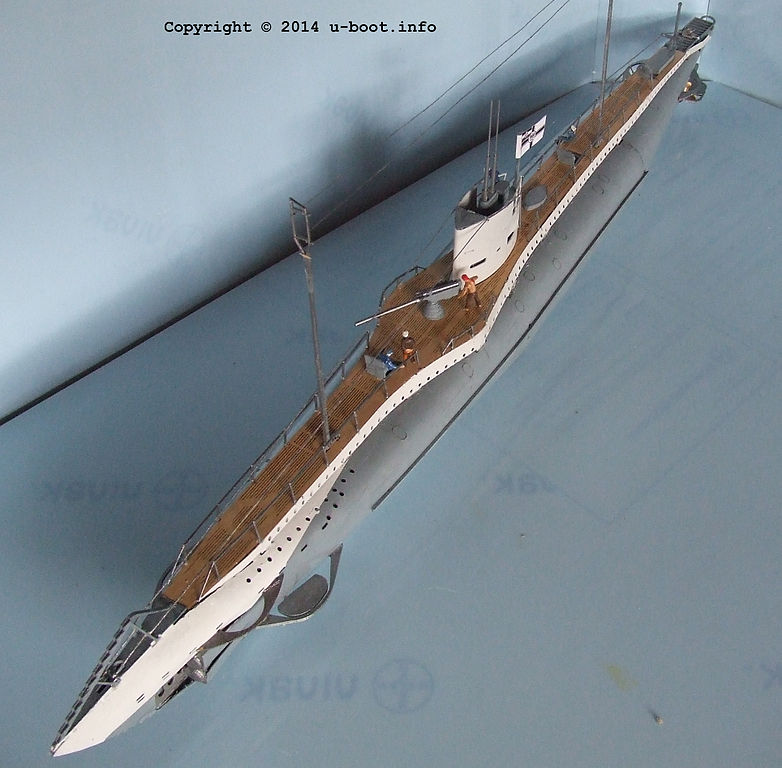

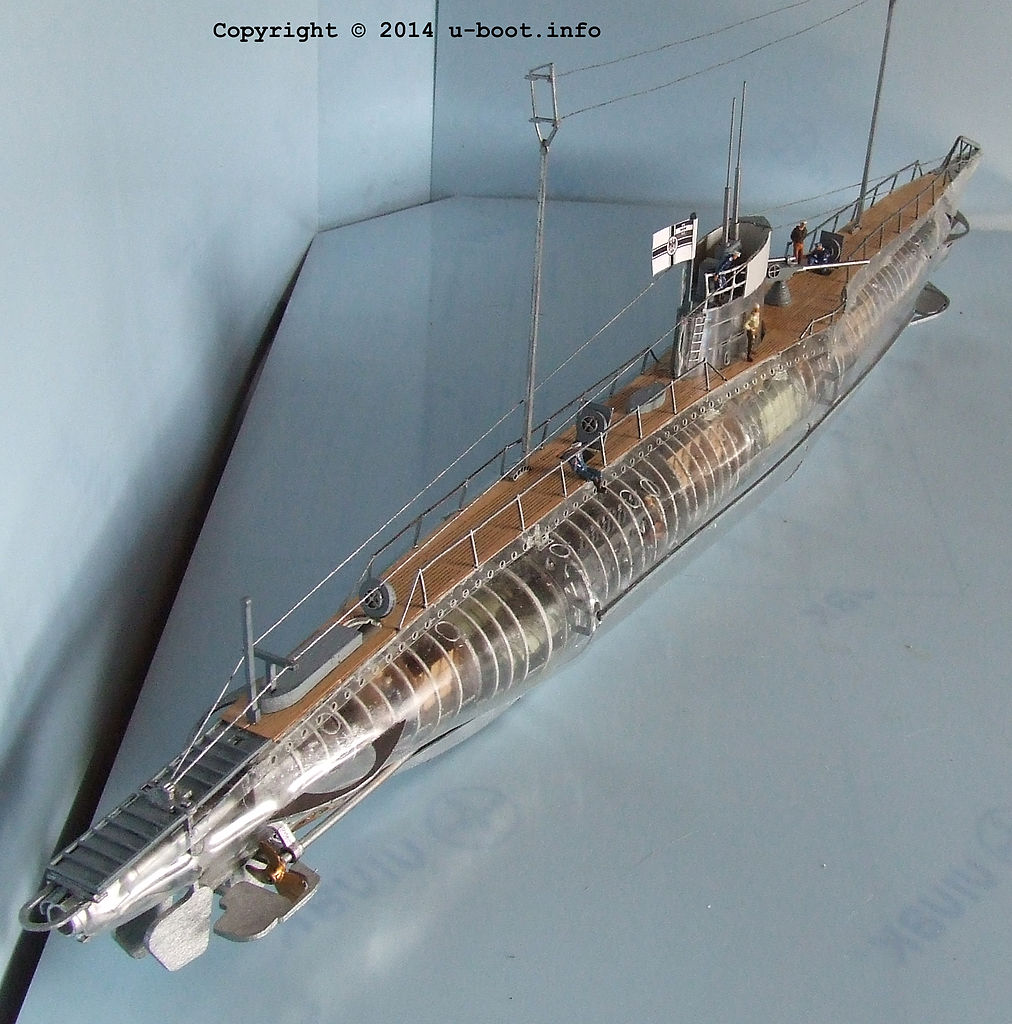
Various views of a cutout model kit (cc)
⚙ UB-III specifications |
|
| Displacement | 508–555 t surfaced/629–684 t submerged |
| Dimensions | 55.30 x 5.76 x 3.67m (181 ft 5 in x 18 ft 11 in x 12 ft) |
| Propulsion | 6-cyl. diesel engines, 1,060 PS (780 kW; 1,045 shp), El.Mot. 788 PS (580 kW; 777 shp) |
| Speed | 13.2 knots (24.4 kph; 15.2 mph)/7.4 knots (13.7 kph; 8.5 mph) |
| Range | 7,120 nmi (13,190 km; 8,190 mi)/6 knots, 50 nmi (93 km; 58 mi)/4 knots submerged |
| Armament | 4× 50 cm bow TTs, stern tube, 10 torp., 1× 8.8 cm (3.5 in) SKL/30/10.5 cm SK L/45 deck gun |
| Test depht/diving time | 50 metres (160 ft), 25-35 sec. |
| Crew | 3+31 |
Construction
In the end, more than 200 UB III boats were ordered, 96 completed but 89 commissioned into the Kaiserliches Marine. Of these, 37 were lost including four in accidents and the rest in action. Surviving ones were surrendered to the Allies according to Armistice terms and were thorouhly examined and even seing extra service under other flags until 1935.
The table below resumes the orders by builder.
⚙ Construction Yards |
|
| UB 48-UB 53 (6) | Blohm & Voss, Hamburg 1916-17 |
| UB 54-UB 59 (6) | A.G. Weser, Bremen 1916-17 |
| UB 60-UB 65 (6) | Vulcan, Hamburg 1916-17 |
| UB 66-UB 71 (6) | Germaniawerft, Kiel 1916-17 |
| UB 72-UB 74 (3) | Vulcan, Hamburg 1916-17 |
| UB 75-UB 79 (5) | Blohm & Voss, Hamburg 1916-17 |
| UB 80-UB 87 (8) | A.G. Weser, Bremen (1916-18) |
| UB 88-UB 102 (15) | Vulcan, Hamburg 1916-18 |
| UB 103-UB 117 (15) | Blohm & Voss, Hamburg 1916-18 |
| UB 118-UB 132 (15) | A.G. Weser, Bremen 1917-18 |
| UB 142-UB 145 (4) | A.G. Weser, Bremen 1917-19 |
| UB 133 | Germaniawerft, Kiel 1917-19 |
| UB 136 | Germaniawerft, Kiel 1917-19 |
| UB 148-UB 150 (3) | A.G. Weser, Bremen 1917-19 |
| UB 154-UB 155 (2) | Vulcan, Hamburg 1917-19 |
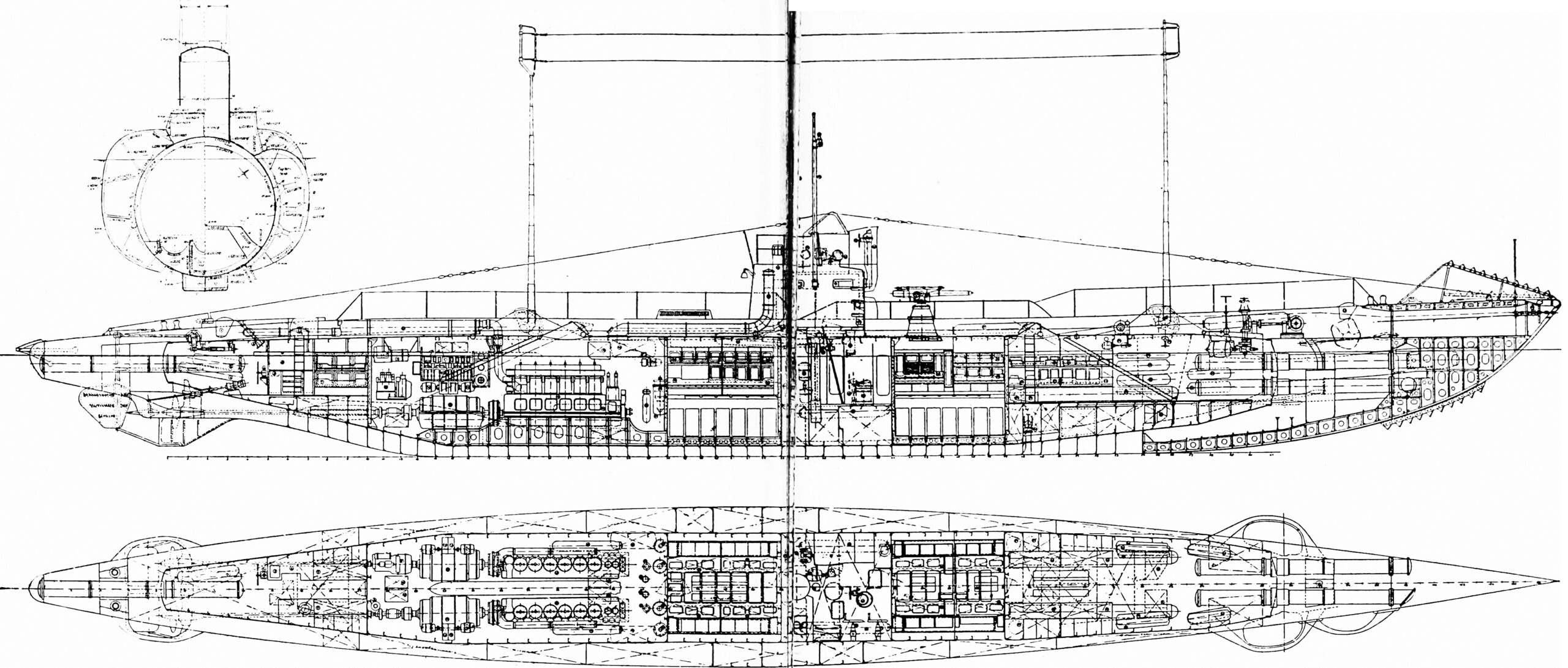
Large scale detailed plan of internals.
Caracteristics by series
UB 48 to UB 53 (B&W):
516 tons/651 tons 55.30 x 5.80 x 3.68 m 13.6 knots/8 knots 9,040 nm/6 knots or 55/4 kts
2x MAN S6V35/35 1100hp 6-cylinder, 4-stroke diesel engines 2x 580 kW SSW electric motors/generators
5x TTs 500mm, 1 MG, from UB 14 1 rotary cannon. UB 12 rebuilt as a minelayer in 1918: 8 mines instead of TTs
UB 54 to UB 59 (AG Weser):
516 tons/646 tons 55.85 x 5.80 x 3.72 m 13.4 knots/7.8 knots 9,020 nm/6 knots or 55/7 knots
2x Körting 1060hp 6-cylinder, 4-stroke diesel engines, 2x 580 kW SSW electric motors/generators
Armament 4x 500mm fwd, 1x 500mm aft, 1x 88mm deck gun (From UB 59 1x 105mm gun)
UB 60 to UB 65 (AG Vulcan Hamburg):
508 tonnes/639 tonnes, 55,52 x 5,76 x 3,70 m, 13,3/8 kts, 8,420 nm/6 kts or 55/4 kts
2x Diesel 6 cyl 4 stroke MAN S6V35/35 1100hp, 2x electric generators SSW 580 kW
Armement: Same but from UB 62, UB 64 one 105mm 1918
UB 66 to UB 71 (Germaniawerft Kiel):
513 tons/647 tons 55.83 x 5.80 x 3.67 m 13.2 knots/7.6 knots 9,090 nm/6 kts or 55 nm/4 knots
2x MAN S6V35/35 1100hp 6-cyl. 4-stroke diesels, 2x 580 kW SSW electric motors/generators
Same and UB 67, UB 68 1918 1x 105mm gun
UB 72 to UB 74 (AG Vulcan):
508 tons/639 tons, 55.52 x 5.76 x 3.70 m, 13.4/7.5 knots, 8,420 nm/6 knots or 55/4 knots
Same as above but UB 73 and UB 74: Körting 1,060hp and same.
Same armament but from UB 73 in 1918: one 105mm gun.
UB 75 to UB 79 (B&V Hamburg):
516 tons/648 tons 55.30 x 5.80 x 3.68 m 13.6 knots/7.8 knots, 8,680 nm/6 kts or 55/4 kts
Same propulsion
Armament same but UB 77 and UB 79 1918: 1x 105mm gun
UB 80 to UB 87 (AG Weser Bremen):
516 tons/647 tons 55.85 x 5.80 x 3.72 m, 13.4/7.5 knots 8,180 nm/6 kns, 50 nm/4 knots
2 Körting 6-cyl. 4-stroke diesel engines 1060hp (UB 82-UB 85: Daimler MU336; UB 86, UB 87: Benz DS375)
2 x 580 kW SSW electric motors/generators
Armament only 4 500mm TTs bow, 1x 88mm deck gun
UB 88 to UB 102 (AG Vulcan Hamburg):
510 tons/640 tons 55.52 x 5.76 x 3.73 m, 13 knots/7.4 knots, max depht 50 meters
Autonomy 7,102 nm/6 knots or 55/4 knots
2x 6 cyl. 4 stroke MAN-Vulcan S6V35/35 1100hp (UB 100-UB 102: AEG), 2x Siemens SSW 580 kW electric motors
Armament: Same as above but 105mm deck gun
UB 103 to UB 117 (Blohm & Voss):
519+ tons (UB 103, UB 105, UB 109: 510 tons) or 649 tons (UB 103, UB 105 and UB 109: 629 tons)
55.30 x 5.80 x 3.70 m, 13.3 knots/7.5 knots 7,420 nm/6 knots, unknown underwater
2x diesels 6 cyl. 4 strikes MAN-Vulcan S6V35/35 1100hp, 2 580 kW Siemens SSW EM (UB 109-UB 114: Maffei; UB 115-UB 118: AEG)
Same as above by 88mm and from 1918 105mm or for UB 115, UB 117 105mm and on UB 106 both 88 and 105mm
UB 118 to UB 132 (AG Weser):
512 tons/643 tons, 55.85 x 5.80 x 3.72 m, 13.9/7.6 knots 7,280 nm/6 knots and 55/4 kts
2x 6-cyl. 4-stroke Daimler MU336 diesels 1060hp (UB 121-UB 127: Körting; UB 128-UB 132: Benz DS375)
2x SSW electric motors/generators (UB 128-UB 132: Schiffsunion) of 580 kW
Same as above TTs but one 105mm (UB 124: 88mm)
UB 142, UB 143, UB 148 and UB 149 (AG Weser Bremen):
523 tons/653 tons, 55.85 x 5.80 x 3.75 m, 13.5/7.5 knot, 7,280nm/6 knots or 50/4
2x Diesel engines 6 cyl. 4 strokes Benz DS375 (UB 149: Körting) 1060hp, 2 Schiffsunion (UB 149: SSW) 580 kW EM
Same as above TTs and one 105mm deck gun for all
Legacy of the UB-III
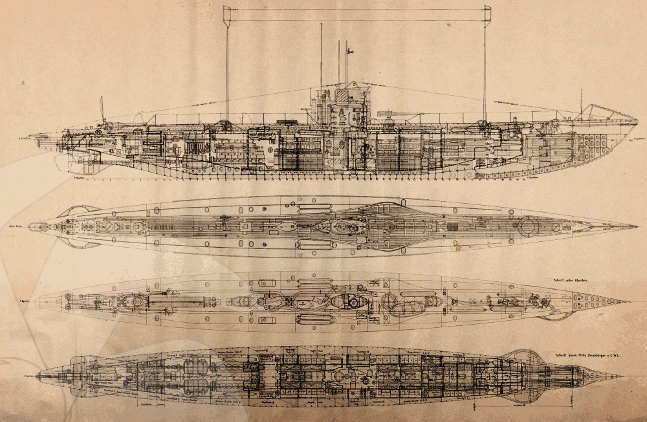
Early blueprints for the Type VIIb, 1936
It was considerable. The rebirth of German submarines despite the Versailles treaty interdiction could only be done out of Germany to avoid the inquisition of the allied commissions. Several options were studied, including an agreement with the USSR in the 1920s, but due to the dire situation post-civil war the option was postponed. A rapprochement was made however later in the 1930s. Instead, Germany through its naval attaché in the neutral (and unscaved by war) Netherlands, to boot a close-germanic language speaking country. And this traduced eventually to the creation of a less risky design bureau instead of a fully flege yard, in what became at The Hague, the infamous “Ingenieurskantoor voor Scheepsbouw”. The best submarine engineers from former Yards came to settled there in 1922, with all the hidden documentation of former WWI submersible models placed there under lock and key. Dutch personal was hired to be placed on the front office.
Netherland having no agreements for inspections from the former entente, there was no obligation to open any of its offices anywhere, and it was not requested.
It does not however prevent the possibility of a French or British spy infiltrating the company, but if real, this remains undiclosed to this day and we have to assume that the future allies knew nothing (but only suspected) such clandestine program. All three yards involved in it, Vulkan Werft (Hamburg) and A.G. Weser/Krupp (Bremen) and Germaniawerft/Krupp (Kiel) kept it top secret.
There was a problem though. If the German state through third-party banks and companies could finance R&D work in this office, there was still a justification to go from theories to practice; In short, an order for a real boat, that cannot be German. Fortunately, the company also rebuilt its prewar yards networks. After some intruigue, the German naval attaché in Turkey convinced the country, which badly needed modern submersibles as deterrence against Greece in which it was at war for two years. And so the first model ever built was for Turkey, as the Birinci Inonu class. Instead of starting from nothing, the engineers simply retook and proposed (with some arm twisting) what was basically a slightly improved UB-III design.
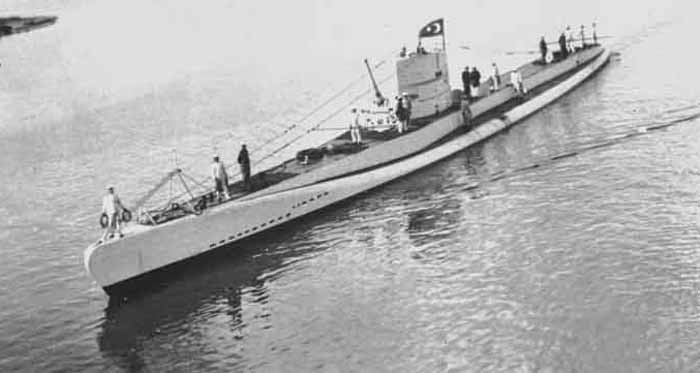
The Birinci İnönü class submersibles, furiously recalling the UB-III
Through First Mentor Bilanz GmbH, and from 1927 Igewit 1 GmbH and Tebeg GmbH, the final draft were ready by 1925 after the order was placed and Fijenoord received the construction order. The new Turkish Submersibles were pretty close to the original UB-III, but of course with improvements:
They displaced 505t surface, 620t submerged for 58.68 x 5.80 x 3.50 m (192.6 x 19 x 11.6 ft) so a bit larger in width and lenght, but with the same hull shape, two MAN diesels 1,100 bhp and 2x Siemens electric motors rated for 700 shp, again pretty close to the original and a top speed surface which was the same at 13.5 but a better 8.5 kts submerged. Surface range was also better, at 9,090 nmi/6 knots surfaced, and 55 nm submerged at 4 knots, same again. Armament was improved by the adoption of two stern tubes however. The Dutch armament was a 75mm gun (3-in) and on the roworked conning tower aft platform later, a Rheinmetall 20mm AA gun was installed. Diving performances were better as the hull was reinforced, giving them 60m (196 ft) and the crew thanks to automation went down to 29.
Thus, the The Hague Bureau was able to deliver the goods for the German Navy, which received all technical reports for its first sea trials. It looked the way formward, but to improve on this concept, completed in 1927, the bureau needed more orders. Turkey would be generous in this, providing a good portion of extra “prototypes” (Gür class, Altilay, Batiray, etc). But also Finland, the USSR, Spain, Sweden, Japan, Romania, Argentina and even indirectly Italy all became customers. By 1933 when the German submarine program was fully reactivated by Hitler, more of these designs were ongoing, with all the range needed by the Kriegsmarine, from the large oceanic types (Type-I) to the coastal Type II/III and the Type VI, later refined as the Type VII, closest based on the “improved UB-III”, the largest submarine program of all times.
The UB-III Type in service
Read More
Books
Bendert, Harald (2000). Die UB-Boote der Kaiserlichen Marine, 1914-1918. Verlag E.S. Mittler & Sohn GmbH.
Gröner, Erich; Jung, Dieter; Maass, Martin (1991). U-boats and Mine Warfare Vessels. German Warships 1815–1945. Vol. 2. Conways
Preston, Anthony (1978). U-Boats. London, England: Bison Books.
Baumgartner, Lothar; Erwin Sieche (1999). Die Schiffe der k.(u.)k. Kriegsmarine im Bild=Austro-Hungarian warships in photographs978-3-901208-25-6.
Gibson, R. H.; Maurice Prendergast (2003). The German Submarine War, 1914–1918. NIP
Imperial and Royal Navy Association. “Tengeralattjárók” (PDF) Imperial and Royal Navy Association.
Jung, Dieter (2004). Die Kaiserliche Marine 1914-1918 und ihr Verbleib. Bernard & Graefe.
Karau, Mark D. (2003). Wielding the Dagger: the MarineKorps Flandern and the German War Effort, 1914–1918. Praeger Publishing.
Messimer, Dwight R. (2002). Verschollen: World War I U-boat losses. NIP
Miller, David (2002). The Illustrated Directory of Submarines of the World. St. Paul, Minnesota
Stern, Robert Cecil (2007). The Hunter Hunted: Submarine versus Submarine: Encounters from World War I to the Present.
Tarrant, V. E. (1989). The U-Boat Offensive: 1914–1945. Annapolis NIP
Williamson, Gordon (2002). U-boats of the Kaiser’s Navy. Oxford: Osprey.
Conway’s All the World’s Fighting Ships 1906–1921
Rossler, Eberhard (1975). The U-boat: The evolution and technical history of German Submarines. Annapolis NIP
Bendert, Harald (2000). Die UB-Boote der Kaiserlichen Marine, 1914-1918. Hamburg Verlag E.S. Mittler & Sohn GmbH.
Gröner, Erich; Jung, Dieter; Maass, Martin (1991). U-boats and Mine Warfare Vessels. German Warships 1815–1945. Vol. 2.
Rössler, Eberhard (1979). U-Bootbau bis Ende des 1. Weltkrieges, Konstruktionen für das Ausland und die Jahre 1935–1945. Bernard & Graefe.
Links
uboat.net ub48.html
u-boote.fr/ub48aub53.htm
u-boote.fr/
dubm.de/u-boat-types
uboat.net
commons.wikimedia.org/
denkmalprojekt.org/
wreckedinmyrevo.com
http://ub88.org/
Model Kits
German UB-III submarine 1917-1935 by Achim Koerver
That’s the only one. A shame that this iconic WWI model was not covered more.
3D
 UB-48
UB-48
UB-48 was commissioned on 11 June 1917 as SM UB-48 under Wolfgang Steinbauer. She conducted nine patrols, sank 35 ships (107,795 GRT) plus a destroyer: the 200t HMS Prize on 14 August 1917. She was also reassigned to the Pola Flotilla and later the II Mediterranean U-boat Flotilla, based in Cattaro. UB-48 was in fact very effective in the Mediterranean under the number U-79 in the Austro-Hungarian Navy, but same crew under Wolfgang Steinbauer. She was scuttled at Pola after the surrender, on 28 October 1918.
 UB-49
UB-49
UB-49 was commissioned on 28 June 1917 as SM UB-49 and she served mainly in the Mediterranean. She served under Hans von Mellenthin with the Austro-Hungarian Navy as SM U-80. She performed eight wartime patrols, sinking 40 ships for 72,817 GRT and one escort. After the Armistice with Germany UB-49 returned to Kiel via Norway. Handed over to the United Kingdom on 16 January 1919, she was broken up in Swansea in 1922.
 UB-50
UB-50
She was commissioned into the Pola Flotilla of the German Imperial Navy on 12 July 1917 as SM UB-50, under KzS Franz Becker.
She conducted conducted seven patrols, sank 40 ships during the for a total of 97,922 gross register tons (GRT) and 16,499 tons of warships. She operated as part of the Pola Flotilla based in Cattaro, surrendered on 16 January 1919 with the rest of the Pola Flotilla after Admiral Reinhard Scheer ordered them to return to port. During her passage through Gibraltar strait for the Adriatic, she managed to sink the battleship HMS Britannia, quite a symbol and feat. UB-50 was given to Britain and broken up at Swansea.
 UB-51
UB-51
UB 51 was commissioned into the Pola Flotilla, 26 July 1917 as SM UB-51. Under Ernst Krafft she operated as part of the Flotilla in Cattaro and surrendered 16 January 1919, like her sister, given to Britain and BU at Swansea.
 UB-52
UB-52
UB-52 was commissioned into the Pola Flotilla, on 9 August 1917 under KzS under Otto Launburg. She operated from Cattaro but was sunk by torpedo on 23 May 1918 by the British submarine HMS H4 on the Otranto Barrage, the gate to the Adriatic, lost with all hands.
 UB-53
UB-53
UB 53 was commissioned into the Pola Flotilla on 21 August 1917, under KzS Robert Sprenger. With the Pola Flotilla she roamed the Adriatic in search of preys and tried to forced the Otranto barrage. Her biggest kill was SS Athenia (1914). On 7 April 1918 she spotted the German Navy Zeppelin L 59 airship crashing near the Strait of Otranto with all hands, coming from Yambol to bomb the Royal Navy base at Malta. But she was claimed by a mine of the Barrage on 3 August 1918. It seems she survived and surfaced before sinking as only 10 went to the bottom with her.
 UB-54
UB-54
UB-54 was commissioned into the Flanders Flotilla in Zeebrugge on 12 June 1917 under KzS Egon von Werner, conducting 6 patrols, sinking 14 ships for a total of 7,200 GRT.
UB-54 was apparently sunk on 11 March 1918 by British destroyers HMS Sturgeon, Thruster, and Retriever by depth charges.
 UB-55
UB-55
She was commissioned into the Flanders Flotilla on 1 July 1917 under Ralph Wenninger. She operated from Zeebrugge, in dangerous waters with stong current and treacherous sand banks. She sank 21 ships (26,598 tons) and 2 damaged (12,809 tons). She sank at 05:05 on 22 April 1918 by a mine, with all hands.
 UB-56
UB-56
She was commissioned into the Flanders Flotilla on 19 July 1917 under KzS Hans Valentiner. She only sank 4 ships (5,387 tons) before hitting a mine at 23:41 on 19 December 1917, all hands.
 UB-57
UB-57
UB-57 was commissioned into the Flanders Flotilla on 30 July 1917 under Otto Steinbrinck and Johannes Lohs as successive captains. She was successful, with 46 ships sunk (122,035 tons) and 11 ships damaged (64,265 tons). But she was sunk at 23:00 on 14 August 1918 after striking a mine.
 UB-58
UB-58
She was commissioned into the Flanders Flotilla on 10 August 1917 under Werner Fürbringer. Only managing to sink 8 ships (8,198 tons). Lik many of her sisters she ws claimed by a mine at 04:15 on 10 March 1918, with all hands.
 UB-59
UB-59
UB-59 was commissioned into the Flanders Flotilla on 25 August 1917 under Erwin Waßner. She sank 7 ships (8,361 tons) and 2 damaged (12,413 tons). UB-59 was scuttled 5 October 1918 off Zeebrugge during the evacuation of Belgium by German forces.
 UB-60
UB-60
UB-60 was commissioned into the Training Flotilla of the German Imperial Navy, on 6 June 1917, based in Kiel under Peter Ernst Eiffe. Thus no sortie or kill. She surrendered to the Allies at Harwich, on 26 November 1918, sold for BU on 3 March 1919 but foundered in tow underway to Swansea on 12 June 1919.
 UB-61
UB-61
She was commissioned on 23 June 1917 as SM UB-61 under Theodor Schultz, conducted three patrols, but onlu sank two ships (12,920 GRT). She hit a mine on 29 November 1917 and sank with all hands.
 UB-62
UB-62
UB-62 was commissioned on 9 July 1917 under Bernhard Putzier, having 8 ships sunk (17,226 tons) and 1 ship damaged (7,300 tons). She surrendered 21 November 1918 after Armistice terms, was attributed to Britainn, the admiralty sold her for BU in Sawansea by 1921.
 UB-63
UB-63
She was commissioned on 23 July 1917 under Rudolf Gebeschus, but she anly sank 3 ships (7,771 tons) with one damaged (1,113 tons). She was sunk on 28 January 1918 by destroyer HMS W.S. Bailey and HMS Fort George with depth charges, with all hands.
 UB-64
UB-64
She was commissioned on 5 August 1917 under successively Otto von Schrader, Walter Gude, Woldemar Petri and Otto von Schrader, with 30 ships sunk (34,120 tons) and 4 ships damaged (48,497 tons).
She surrendered to the British on 21 November 1918, BU in Fareham in 1921.
 UB-65
UB-65
UB-65 was commissioned on 18 August 1917, under the command of Kapitänleutnant Martin Schelle, sailed six war patrols, sinking 7 ships, damaging 6 more (7,487 tons and 11,443 tons.) and the Anchusa-class sloop HMS Arbutus. However she was lost off Padstow, Cornwall circa 14 July 1918 with all hands in unknown circumstance as there never was a minefield in this area. However the mistery did not last forever:
An expedition was mounted in 2004 for Channel 4 “Wreck Detectives” to survey a previously unidentified U-boat wreck located earlier during a routine survey by the Royal Navy. Divers conformed she was indeed UB-65. Inspection of the wreck by Innes McCartney and Dr. Axel Niestlé proved conclusively her identity, and examination led to think she was lost through accidental causes.
 UB-66
UB-66
UB-66 was commissioned on 1 August 1917 under Fritz Wernicke, which sank the sailing vessel Martha (412t) and on 17 January 1918 under Fritz Wernicke the SS Windsor Hall. Herself was sunk by the flower class sloop HMS Campanula on 18 January 1918.
 UB-67
UB-67
UB-67 was commissioned on 23 August 1917 under Gerhard Schulz and from 10 Nov 1918 Hellmuth von Doemming. They sank two ships, SS Aurania 13,936 tons and the paddle minesweeper Ascot. She served as training U-Boat in the Mediterranean before being surrendered to the British on 24 November 1918, BU at Swansea in 1922.
 UB-68
UB-68
UB-68 was commissioned on 5 October 1917 under Heino von Heimburg, conducted five patrols and sank five ships. But she was also under the command of Karl Dönitz and sank the 3,883t Steamer Oopack. But on 4 October 1918 she encountered technical problems, surfaced, was spotted and sunk by gunfire, with just one dead, 33 survivors including Dönitz. Other sources claims she was sunk by HMS Snapdragon and HMS Cradosin, and four dead.
 UB-69
UB-69
UB-69 was commissioned on 12 October 1917 under KzS Alfred Klatt. She made one patrol, no kill, and was sent in the Mediterranean when sunk on 9 January 1918 by HMS Cyclamen. 31 went down with her.
 UB-70
UB-70
UB-70 was commissioned on 29 October 1917 under Johannes Remy. She made 2 patrols and sank the French 1,794t Valdivia in the Mediterranean. She sank on 2 May 1918 for her third patrol on 16 April 1918, last heard from on 5 May 1918 east of Gibraltar. Her loss remains a mistery but the area is difficult to explore.
 UB-71
UB-71
Ub-71 was commissioned 23 November 1917 under Kurt Schapler, served in the Mediterranean and sunk by depth charges in her first sortie by HMS ML413 off Menorca on 21 April 1918.
 UB-72
UB-72
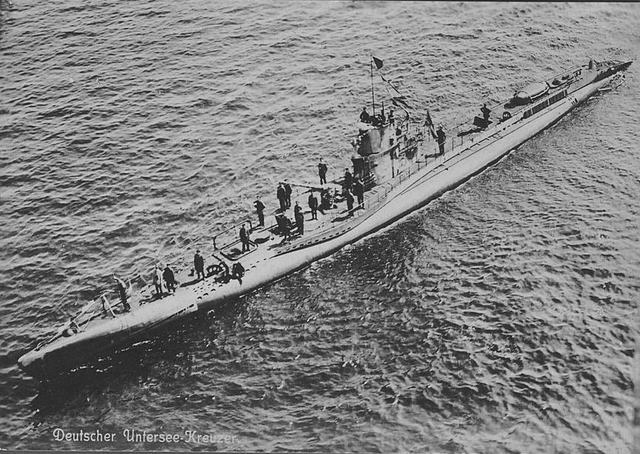
UB-72 was commissioned on 9 September 1917 under first Walter Creutzfeldt and later KzS Friedrich Traeger with the II and V Flotilla. She sank 5 ships (10,551 tons), damaged one of 3,358 tons.
Norwegian Svanfos, HMS Tithonus, Norwegian Vafos, British Sandhurst, Quito, Baron Ailsa but was caught on the English Channel by HMS D4 torpedoes and sunk on 12 May 1918.
 UB-73
UB-73
She was commissioned on 2 October 1917 under Karl Neureuther, with 9 ships sunk (19,301 tons), Dutch Catriena, British Myrtle Branch, Chelford, Ladoga, Lodaner, Dalegarth Force, Orissa and Norwegian Mountain Laurel but on 24 June 1918 she spotted and sank the RN submarine HMS D6, which was no small feat, all in the Mediterranean. On 21 November 1918 she was surrendered to France, interned in Cherbourg (see the WW2 French subs for more).
 UB-74
UB-74
UB-74 was commissioned on 24 October 1917 under KsZ Ernst Steindorff, which had 7 ships sunk (13,294 tons) and 3 damaged (12,817 tons) as part of the Flanders Flotillas. On 26 May 1918 she was sunk by HMS Lorna in the English channel.
 UB-75
UB-75
UB-75 was commissioned on 11 September 1917 under Franz Walther. She sank 6 ships (10,777 tons) and one damaged (1,477 tons) as part of the Flanders Flotillas. On 10 December 1917 she was lost with all hands after hitting a mine.
 UB-76
UB-76
UB-76 was commissioned on 23 September 1917 under Kptlt. Erich Gerth, no patrol as she served with the Training Flotilla. On 12 February 1919 she was surrendered to Britain and BU in Rochester in 1922.
 UB-77
UB-77
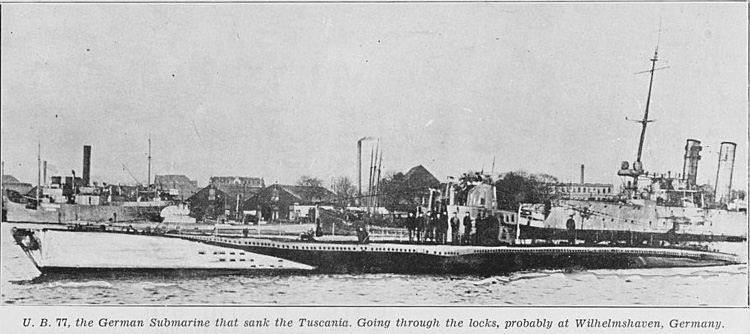
UB-77 was commissioned under command of Kptlt. Wilhelm Meyer. She had moderate success with only 1 ship sunk (14,348 tons) and 2 damaged (28,174 tons). She surrendered on 16 January 1919 to the RN, BU in Swansea in 1921.
 UB-78
UB-78
She was commissioned on 20 October 1917 under Arthur Stoßberg, having 2 ships sunk (1,241 tons) and 2 damaged (7,040 tons, hit a Mine off Dover on 19 April 1918, all hands lost.
 UB-79
UB-79

Unidentified UB-III surrendered, at anchor at Portsmouth, with HMS Renown and POW leaving port.
She was commissioned on 27 October 1917 under Woldemar Petri, apparently served as training sub. She was surrendered in accordance to Armistice terms on 26 November 1918, attributed to UK, sold, BU at Swansea in 1922.
 UB-80
UB-80
One of the most successful boats, she was commissioned into the German Imperial Navy on 8 September 1917 under Max Viebeg (Pour le Mérite), made 10 patrols, sinking 20 ships (35,478 tons) and 5 ships damaged (26,322 tons) and after V-Day surrendered to Italy in accordance with Armistice terms, BU at La Spezia in May 1919.
 UB-81
UB-81
UB-81 was commissioned on 18 September 1917 under Oblt. Reinhold Saltzwedel (Pour le Mérite), served with the Flandern I Flotilla, made 2 patrols, sank on 1 Dec 1917 the steamer SS Molesey (3,218). She was sank herself on 2 December 1917 by a mine in the channel, with all hands.
 UB-82
UB-82
UB-82 was commissioned on 8 September 1917 under Walther Gustav Becker. She made 3 patrols with the III flotilla, no kill. She was sunk on 17 April 1918 by HMS Pilot Me and HMS Young Fred with all hands.
 UB-83
UB-83
UB-83 was commissioned on 15 October 1917 under Günther Krause and later Oblt. Hans Buntebardt, both in the V flotilla. She made 6 patrols, only sunk the steamer Aulton (634t) and damaged the tank Meline (6,970 GRT). UB-83 was sunk on 10 September 1918 by HMS Ophelia off Orkney with all hands.
 UB-84
UB-84
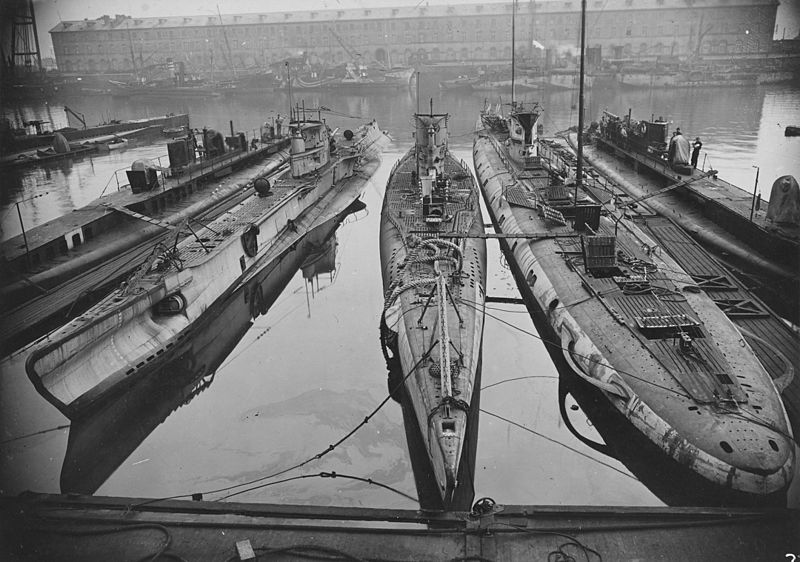
UB-IIIs Interned in Cherbourg in 1919 (identity unknown)
She was commissioned on 31 October 1917 under Kptlt. Max Bräutigam. She made no sortie or kill, but was lost in a collision on 7 December 1917 in the Baltic Sea in Eckernforde Bay by the torpedo target ship Solingen. 7 crew members in the engine room went down with her (she was surfaced). Raised and repaired she never had the time to return to front-line service. Instead, still a training boat she was surrendered on 26 November 1918 to the French, BU in Brest in 1921.
 UB-85
UB-85
UB-85 was commissioned on 24 November 1917 under Kapitänleutnant Günther Krech, V flotilla. On her second patrol, she was spotted by HM Drifter Coreopsis II off the coast of Belfast on 30 April 1918. She suffered issues and was partially flooded through a semi-open hatch as she tried to escape her. The ingress of water became uncontrollable and so she was surfaced to be abandoned by the crew, while under fire. No casualty, all became POW. The captain allegeldy reported the previous night when recharging batteries “a large sea creature” damaged his boat, unable to submerge, and the beast was forced out using sidearms. It seems this is a scam appeared on internet on 2005 as researched by Dr Innes McCartney.
 UB-86
UB-86
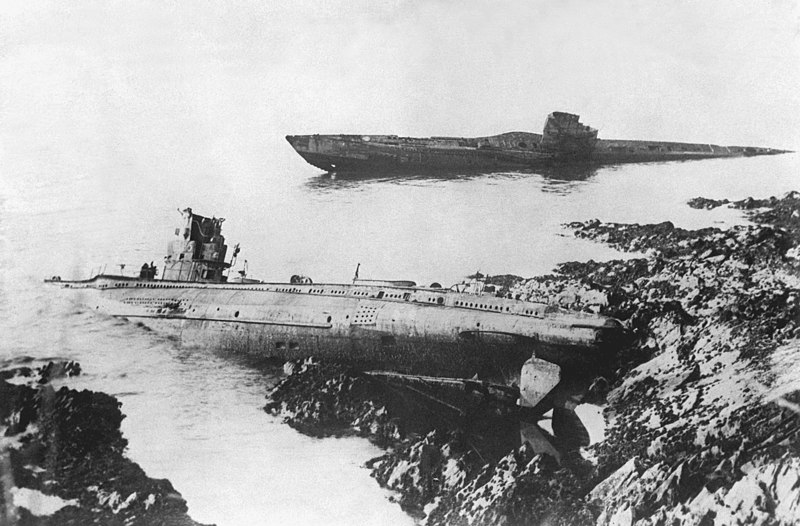
She was commissioned on 31 October 1917 under Kptlt. Hans Trenk. She made 5 patrols, with the V and III flotilla, with 4 ships sunk (5,876 tons), one 1,735 tons damaged and another for 14,150 tons. She surrendered to the Allies at Harwich on 24 November 1918, and towed to Falmouth along with five other U-boats to be used in a series of explosive test trials to find weaknesses in their design. On 14 January 1921 after tests she was dumped on Castle Beach, sold for BU on 19 April 1921 partially salvaged over the following decades.
 UB-87
UB-87
commissioned on 27 December 1917 under Kptlt. Karl Petri and later Oblt. Bernhard Hibsch in the V and III flotillas, UB-87 sank in 5 patrols 3 ships (18,671 tons), damaged one (12,045 tons SS Petri, Passenger steamer). She surrendered to France on 20 November 1918 as per Armistice terms, BU in Brest in 1921.
 UB-88
UB-88
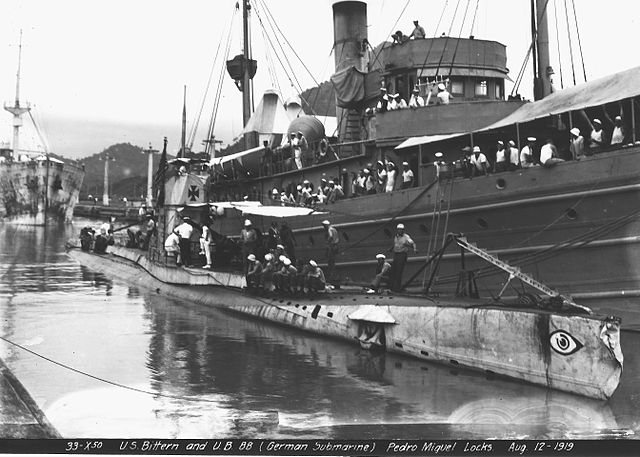
UB-88 alonsgide USS Bittern, in internment.
She was commissioned on 26 January 1918 under Oblt. Johannes Ries and later Kptlt. Reinhard von Rabenau (awarded the Royal House Order of Hohenzollern award). She serrved woth the Flandern I Flotilla and II Flotilla, sinking 14 ships (31,076 tons), 2 damaged (10,135 tons). On 26 Nov 1918 she surrendered to the USA, was used for exhibitions along the Atlantic coast going from the Gulf of Mexico to the coast of Panama and West Coast. She was abundantly tested and inpected with drawing made down to the rivet. When all intel was done, she was used for tests, shot at as gunnery target by the destroyer USS Wilkes, and scuttled at San Pedro in California on 3 January 1921. The USN wanted to test her vulnerability to her Wickes/Clemson class destroyers.
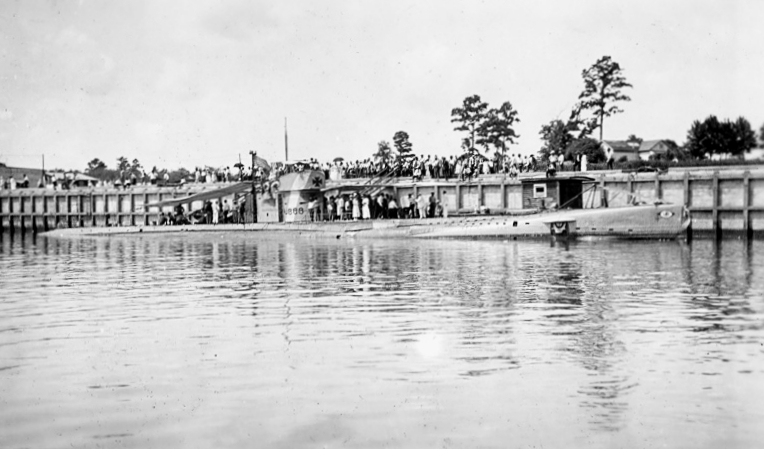
UB 88 in the US by the 1920s
 UB-89
UB-89
UB-89 was commissioned on 25 February 1918 under Kptlt. Walter Gude, II flotilla; She only made 3 patrols, with 2 small ships sunk for 373 tons. She was lost in a collision with the light cruiser SMS Frankfurt in Kiel. 7 died in the tragedy, but on 30 October 1918 she was raised by salvage ship SMS Cyclop and by 7 March 1919, en route to surrender she started to drift towed to Ymuiden, BU nearby in Dortrecht.
 UB-90
UB-90
Commissioned on 21 March 1918 as SM UB-90 under Oblt. Gottfried von Mayer for the II flotilla, patrolled northern waters, she carried out 2 patrols and sank the 3575 tons Eupion and captured the 850 tons Danish Douro. Captures were excessively rare at the time. On 16 Oct 1918 she was torpedoed by HM Sub L12 in the Skagerrack, all hands lost.
 UB-91
UB-91
Ub-91 was commissioned on 11 April 1918 under Kptlt. Wolf Hans Hertwig for the II flotilla. She made 2 patrols with 3 ships sunk (13,487 tons) and the 1180t USS Tampa for the coast guard. She aslo on 4 October 1918 sank the Hirano Maru, claiming the Yokohama Specie Bank sub-manager S. Ujie and family bank employee. Germany was indeed at war with Japan from 1914.
She surrendered to Britain on 21 November 1918 at Harwich, and like another boat, was used for public displays tours at South Wales, Cardiff, Newport, Swansea, Port Talbot until towed to Pembroke Dock and BU by Briton Ferry in 1921. The deck gun ended at Chepstow as part of the War Memorial.
 UB-92
UB-92
UB-92 was commissioned on 27 April 1918 under Kptlt. (R) Franz Krapohl and later Oblt. Johannes Paul Müller in the II flotilla and moderately successful. She made 2 patrols with 8 ships sunk with a total of 17,189 tons. She surrendered to Britain on 21 November 1918, was BU on Bo’ness in 1919/20.
 UB-93
UB-93
UB-93 was commissioned on 15 May 1918 under Oblt. (R) Karl Thouret and later Kptlt. Friedrich Götting, for the II flotilla, made 2 patrols, no kill. UB-93 was surrendered to Britain, on 21 November 1918 BU in Rochester, 1922.
 UB-94
UB-94

UB 94 interned at Cherbourg
UB-94 was commissioned on 1 June 1918 under Kptlt. Waldemar Haumann, making 2 patrols with the II Flotilla, sinking 2 ships (3,261 tons). She surrendered to France on 22 November 1918. Interned in Cherbourg. Later after some language conversions, she served in th Marine Nationale as Trinité-Schillermans until 24 July 1935, later BU.
 UB-95
UB-95
She was commissioned on 20 June 1918 under Kptlt. Oscar Maaß and served with the II flotilla, made a single patrol and sunk the Nyanza Steamer 4,053t. She was surrendered to Italy on 21 November 1918, BU in La Spezia by August 1919.
 UB-96
UB-96
UB 96 was commissioned on 3 July 1918 under Oblt. Walter Krastel. She made a single patrol for the II flotilla, no success. She was surrendered to Britain on 21 November 1918, BU in Bo’ness in 1919/20.
 UB-97
UB-97
UB 97 was commissioned on 25 July 1918 under Ltn. (R) Oskar Brinkmann and later Oblt. Georg Stollenz in the training flotilla, in the Baltic. She was surrendered to the Allies at Harwich on 21 November 1918, was towed to Falmouth for explosive test trials and by 7 March 1921 left on Castle Beach to be sold for BU (for just £50) over the years from 19 April 1921.
 UB-98
UB-98
UB-98 was commissioned on 8 August 1918 under Oblt. Richard Scheurlen, she made a single patrol, no success. She was surrendered on 21 November 1918, BU Porthmadog in 1922.
 UB-99
UB-99
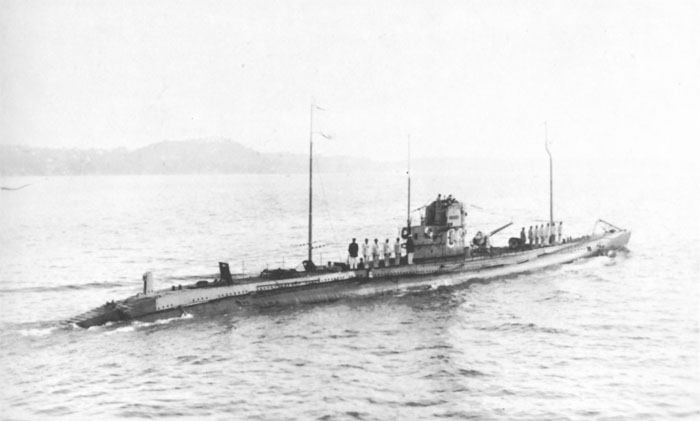
Ex-UB-99 Under French service as Carissan in the interwar
She was commissioned on 4 September 1918 under Oblt. Erich Förste for the I flotilla, but was still training when the war ended. She was surrendered on 21 November 1918 and served in the French Navy until 1935 under the name Carissan.
 UB-100
UB-100
She was commissioned on 17 September 1918 under Oblt. Fritz Lamprecht and was still training when the war ended. She surrendered on 22 November 1918 to to Britain, was broken up in Dortrecht in 1922.
 UB-101
UB-101
She was commissioned on 31 October 1918 under Oblt. Eugen von Beulwitz, same story here. She was surrendered on 26 November 1918, BU in Felixstowe in 1919.
 UB-102
UB-102
Commissioned on 17 October 1918 under Oblt. Konrad Limann. Surrendered to Italy on 22 November 1918, BU in La Spezia, July 1919.
 UB-103
UB-103
Commissioned on 18 December 1917 under Kptlt. Paul Hundius (awarded Pour le Mérite), UB-103 made 6 patrols for the Flandern I flotilla, with 15 ships sunk for a total of 25,999 tons.
She was sunk in the English Channel by British warships and SSZ 1 (a RN blimp), sank wih all hands. The sinking proved the worth of blimps for ASW reconnaissance and warfare.
 UB-104
UB-104
UB 104 was commissioned on 15 March 1918 under Oblt. Ernst Berlin and Oblt. Thomas Bieber (Royal House Order of Hohenzollern) in the Flandern II flotilla, making 3 patrols with 11 ships sunk (15,958 tons GRT). She hit a mine at the Northern Barrage, on 19 September 1918.
 UB-105
UB-105
UB 105 was commissioned on 14 January 1918 under Kptlt. Wilhelm Marschall (Pour le Mérite) and Oblt. Rudolf Petersen. She served with the Mittelmeer I Flotilla (Pola), sinking 25 ships for 64,764 tons and the 1,290 tons HMS Cowslip. She was surrendered to Britain, on 16 January 1919, BU Felixstowe in 1922.
 UB-106
UB-106
She was commissioned on 7 February 1918 under Oblt. Hugo Thielmann and later Oblt. Max Schmidt? No patrol, she surrendered on 26 Nov 1918 and after tests she was grounded near Falmouth with UB 86, UB 97, UB 112, UB 128 and UC 92, sold and BU on site.
 UB-107
UB-107
UB 107 was commissioned on 16 February 1918 under Kptlt. Hans Howaldt (Pour le Mérite) and later Kptlt. Eberhard von Prittwitz und Gaffron. She made 4 patrols for the Flandern II Flotilla, sank 11 ships for 26,147 GRT. UB-107 was sunk on 27 July 1918 by HMS Vanessa (D29) and HMT Calvis for some sources, or unknown causes in August one mile north of Flamborough.
 UB-108
UB-108
UB-108 was commissioned on 1 March 1918 under Oblt. Wilhelm Amberger for the Flanders I Flotilla. She made 3 patrols, sank 2 ships (2,655 tons) but was lost in July 1918 in the English Channel, likely hitting a mine.
 UB-109
UB-109
UB-109 was commissioned on 31 December 1917 under Kptlt. Kurt Ramien (Royal House Order of Hohenzollern), making 3 patrols for the Flandern I Flotilla, sinking 7 ships (14,092 tons), sunk by mine in the English Channel on 29 August 1918, part of the Dover Barrage. Divers’s survey showed her broken in half.
 UB-110
UB-110
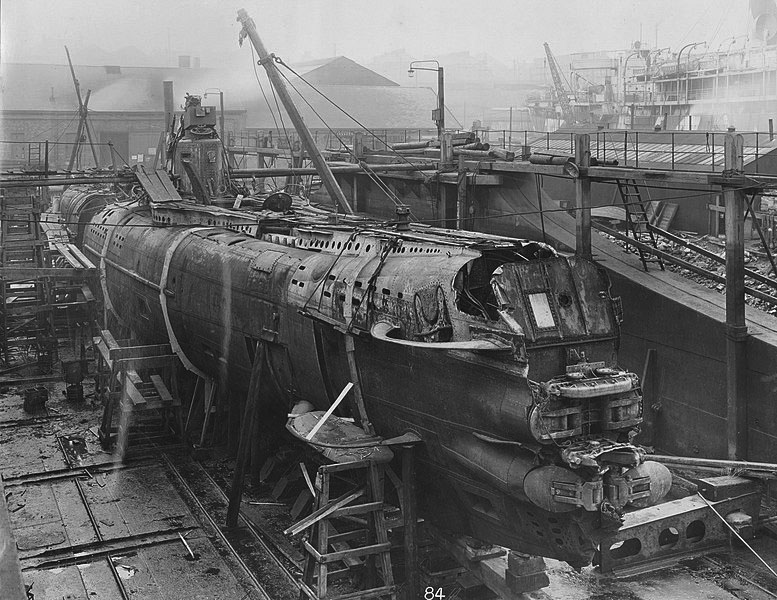
Ub 110 was commissioned in the spring of 1918 under the command of Kptlt. Werner Fürbringer. As part of the Flandern II Flotilla she made 2 patrols, having one ship sunk 3,709 ton
and one damaged (1,137 tons). She was sunk on 19 July 1918, depth charged, rammed, sunk near the Tyne by HMS Garry (Cap. Charles Lightoller of Titanic fame). Perhaps the last U-Boat sunk in this war.
 UB-111
UB-111
She was commissioned on 5 April 1918 Kptlt. Egon von Werner (Royal House Order of Hohenzollern), making 3 patrols for the Flandern II Flotilla and II Flotilla, with 7 small ships sunk (694 tons).
She surrendered to Britain on 21 November 1918, BU in Bo’ness 1919-20.
 UB-112
UB-112
UB-112 was commissioned on 16 April 1918 under Kptlt. Wilhelm Rhein (awared the Royal House Order of Hohenzollern medal). She carried out 3 patrols, until 18 Oct 1918 for the Flandern II Flotilla
and afterwards for the III Flotilla, sinking 11 ships (10,459 tons), 1 damaged (1,960 tons). She surrendered at Harwich on 24 November 1918, was used for explosives trials off Falmouth on 20 November; 1 December 1920, dumped on Castle Beach sold and scrapped over decades by R. Roskelly & Rodgers on site.
 UB-113
UB-113
Commissioned on 25 April 1918 under Oblt. Ulrich Pilzecker she carried out 2 patrols for the Flandern II Flotilla, sinking 3 ships (4,013 tons GRT) and lost in autumn 1918 for unknown reasons, possibly after being destroyed by the French gunboat l’Engageante on 29 August in the Gulf of Gascony, alternative with UB-123, but what is sure is she Left Zeebrugge for the western English Channel, north route on 14 Sep 1918, disappeared without a trace.
 UB-114
UB-114
Commissioned on 4 May 1918 under Oblt. Ernst Berlin she trained when and sank on trials on 13 May 1918 in Kiel harbour (7 sailors dead). Refloated, she was to complete her trials but was surrendered at Harwich on 21 November 1918, assigned as French war reparations but sunk while under tow to a French port, in early 1919, the wreck identified and located in 2013.
 UB-115
UB-115
UB 115 was commissioned on 28 May 1918 under Oblt. Reinhold Thomsen, making 2 patrols for the Flandern I Flotilla and sinking only the 336 tons steamer Staithes. She was sunk by HMS Ouse and HMS Star after being tracked from the air by the airship R29, which also dropped aerial bombs.
 UB-116
UB-116
Commissioned on 24 May 1918 under Oblt. Erich Stephan and later Oblt. Hans Joachim Emsmann, making 4 patrols for the Flandern I Flotilla and from 4 October 1918, the III Flotilla. She had no success, and was sunk by a remote-controlled mine off Orkney during an attempt to enter Scapa Flow (final German Naval offensive) and could have been finished off by depth charges.
 UB-117
UB-117
Commissioned on 6 May 1918 under Kptlt. Erwin Waßner (awarded Pour le Mérite) she carried out 3 patrols for the Flandern I Flotilla and II Flotilla, sinking 5 ships (9,342 tons), surrendered to the British on 26 November 1918, BU in Felixstowe after the war.
 UB-118
UB-118
Commissioned on 22 January 1918 under Kptlt. Hermann Arthur Krauß, she made 5 patrols for the III Flotilla, sinking 5 ships (19,902 tons). She was surrendered at Harwich on 21 November 1918, used for British explosive trials at Falmouth and later sank while in tow from Devonport to Falmouth on 21 November 1920.
 UB-119
UB-119
UB 119 was commissioned on 9 February 1918 under Oblt. Walter Kolbe, making a single 1 patrol for the III Flotilla (no kill). She was rammed and sunk in the Atlantic, off Rathlin Island (Ireland) by the steamer Green Island, sinking with all hands. That kind of civilian ship attack was fairly rare and the captain was certainly given accolades upon arrival.
 UB-120
UB-120
Un 120 commissioned on 23 March 1918 under Oblt. Richard Plum, making 2 patrols for the III Flotilla, only sinking the 145 tons Danish steamer Ludvig on 3 August 1918. Surrendered to the British on 24 November 1918, BU in Swansea, 1922.
 UB-121
UB-121
She was commissioned on 10 February 1918 under Oblt. Albrecht Schmidt, carried out 3 patrols for the III Flotilla, no success. She surrendered at Harwich on 20 November 1918, was transferred to France in 1919, but while in tow to Brest with U-118, ran aground at Birling Gap, 15 April 1919. The wreck was sold on 3 May 1919, BU on site.
 UB-122
UB-122
She was commissioned on 4 March 1918 under Oblt. Alexander Magnus, making 2 patrols for the III Flotilla (no kill). She surrendered at Harwich on 20 November 1918, being exhibited at Southampton by December 1918, laid up at Portsmouth and scuttled in the channel on 1 July 1921. The remainder of UB-IIIs not listed here were never commissioned, and all were BU on slip or at berth after completion was cancelled at various ranges.
 UB-123
UB-123
She was commissioned on 6 April 1918 under Oblt. Robert Ramm, making 2 patrols with the III Flotilla, sinking a 2,646 tons steamer, damaging another 4,095 tons ship and took three as prize (3,530)
She torpedoed and sunk the steamer Leinster (City of Dublin Steam Packet Company) on 10 October 1918 outside Dublin Bay, 500 went down with her. UB-123 struck a mine at the North Sea Mine Barrage on 19 October 1918, with all hands.
 UB-124
UB-124
Commissioned on 22 April 1918 under Oblt. Hans Oscar Wutsdorff she made a single patrol for the III Flotilla sinking on 20 Jul 1918 the 32,234t liner SS Justicia. She was sunk on 20 July 1918 by HMS Marne, Milbrook, Pigeon, and a fleet of 30 patrol craft. She had experience issues and was unable to dive, so she was gunned at the surface and the captain ordered to abandon ship, only two died on the event.
 UB-125
UB-125

Commissioned on 18 May 1918 under Kptlt. Fritz Schubert and from 21 Jul 1918 Oblt. Werner Vater with the III Flotilla, making 2patrols, sinking 6 ships (total of 13,307 tons), one 6,082 tons damaged. She was surrendered on 20 November 1918 and handed over to Japan. She became O-6 or “Maru 6” in Imperial Japanese Navy service until 1921, then BU in Kure.
 UB-126
UB-126

Commissioned on 20 April 1918 under Oblt. Waldemar von Fischer, she made 3 patrols for the III Flotilla, sinking 2 ships (3,078 tons). She was surrendered 24 November 1918 to France and used for underwater explosion tests, BU at Toulon, July 1921.
 UB-127
UB-127
Commissioned on 1 June 1918 under Oblt. Walter Scheffler she made a single patrol for the I Flotilla, no success, and was lost at the North Sea Mine Barrage in September 1918. Possibly South of Fair Isle passag around 9 Semptember, declared lost on the 30th.
 UB-128
UB-128
Commissioned on 11 May 1918 under Kptlt. Wilhelm Canaris (yes, this one), she made 2 patrols with the Mittelmeer I Flotilla (Pola flotilla), sinking only the 7,418t steamer Champlain. She was surrendered to the Allies at Harwich, 3 February 1919 used off Falmouth for explosive test trials and 1 February 1921, dumped on Castle Beach, sold and scrapped over the years on site.
 UB-129
UB-129
Commissioned on 11 June 1918 under Kptlt. Karl Neumann (awarded the Royal House Order of Hohenzollern), she made a single patrol for the Mittelmeer I Flotilla sinking two ships for 5,098 tons. She was scuttled on 31 October 1918 in Fiume after the surrender of Austria-Hungary.
 UB-130
UB-130
She was commissioned on 28 June 1918 under Kptlt. Heinrich XXXVII Prinz Reuß zu Köstritz, made a single patrol (no kill) for the I Flotilla, surrendered at Harwich on 26 November 1918, sank in tow to a French port off Hastings or as uboat.net suggests, used for underwater explosion tests, BU at Toulon in July 1921.
 UB-131
UB-131
Commissioned on 4 July 1918 under Kptlt. Gerhard Schulz she made no patrols (not operational at V day), she surrendered at Harwich on 21 November 1918 and wrecked near Bulverhythe on 9 January 1921 while in tow from Harwich to Falmouth for explosive trials, BU in situ.
 UB-132
UB-132
Commissioned on 25 July 1918 under Oblt. Horst Obermüller, no patrol, she surrendered on 21 November 1918, later Broken up at Swansea.
 UB-133
UB-133
Completed after the end of the war she was not commissioned, surrendered to Britain, BU by 1922 in Rochester. I will not dwelve into the next ships, UB 136, UB 148, UB 149, UB 150, UB 154 and
UB 155 which had more of less the same fate. UB-148 was briefly under command of Oblt. Walter Warzecha during completion, and UB-149 Kptlt. Bernhard Gerke.

 Latest Facebook Entry -
Latest Facebook Entry -  X(Tweeter) Naval Encyclopedia's deck archive
X(Tweeter) Naval Encyclopedia's deck archive Instagram (@navalencyc)
Instagram (@navalencyc)





 French Navy
French Navy Royal Navy
Royal Navy Russian Navy
Russian Navy Armada Espanola
Armada Espanola Austrian Navy
Austrian Navy K.u.K. Kriegsmarine
K.u.K. Kriegsmarine Dansk Marine
Dansk Marine Nautiko Hellenon
Nautiko Hellenon Koninklije Marine 1870
Koninklije Marine 1870 Marinha do Brasil
Marinha do Brasil Osmanlı Donanması
Osmanlı Donanması Marina Do Peru
Marina Do Peru Marinha do Portugal
Marinha do Portugal Regia Marina 1870
Regia Marina 1870 Nihhon Kaigun 1870
Nihhon Kaigun 1870 Preußische Marine 1870
Preußische Marine 1870 Russkiy Flot 1870
Russkiy Flot 1870 Svenska marinen
Svenska marinen Søværnet
Søværnet Union Navy
Union Navy Confederate Navy
Confederate Navy Armada de Argentina
Armada de Argentina Imperial Chinese Navy
Imperial Chinese Navy Marinha do Portugal
Marinha do Portugal Mexico
Mexico Kaiserliche Marine
Kaiserliche Marine 1898 US Navy
1898 US Navy Sovietskiy Flot
Sovietskiy Flot Royal Canadian Navy
Royal Canadian Navy Royal Australian Navy
Royal Australian Navy RNZN Fleet
RNZN Fleet Chinese Navy 1937
Chinese Navy 1937 Kriegsmarine
Kriegsmarine Chilean Navy
Chilean Navy Danish Navy
Danish Navy Finnish Navy
Finnish Navy Hellenic Navy
Hellenic Navy Polish Navy
Polish Navy Romanian Navy
Romanian Navy Turkish Navy
Turkish Navy Royal Yugoslav Navy
Royal Yugoslav Navy Royal Thai Navy
Royal Thai Navy Minor Navies
Minor Navies Albania
Albania Austria
Austria Belgium
Belgium Columbia
Columbia Costa Rica
Costa Rica Cuba
Cuba Czechoslovakia
Czechoslovakia Dominican Republic
Dominican Republic Haiti
Haiti Hungary
Hungary Honduras
Honduras Estonia
Estonia Iceland
Iceland Eire
Eire Equador
Equador Iran
Iran Iraq
Iraq Latvia
Latvia Liberia
Liberia Lithuania
Lithuania Mandchukuo
Mandchukuo Morocco
Morocco Nicaragua
Nicaragua Persia
Persia San Salvador
San Salvador Sarawak
Sarawak Uruguay
Uruguay Venezuela
Venezuela Zanzibar
Zanzibar Warsaw Pact Navies
Warsaw Pact Navies Bulgaria
Bulgaria Hungary
Hungary

 Bundesmarine
Bundesmarine Dutch Navy
Dutch Navy Hellenic Navy
Hellenic Navy Marina Militare
Marina Militare Yugoslav Navy
Yugoslav Navy Chinese Navy
Chinese Navy Indian Navy
Indian Navy Indonesian Navy
Indonesian Navy JMSDF
JMSDF North Korean Navy
North Korean Navy Pakistani Navy
Pakistani Navy Philippines Navy
Philippines Navy ROKN
ROKN Rep. of Singapore Navy
Rep. of Singapore Navy Taiwanese Navy
Taiwanese Navy IDF Navy
IDF Navy Saudi Navy
Saudi Navy Royal New Zealand Navy
Royal New Zealand Navy Egyptian Navy
Egyptian Navy South African Navy
South African Navy






























 Ukrainian Navy
Ukrainian Navy dbodesign
dbodesign